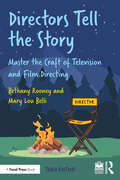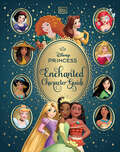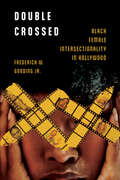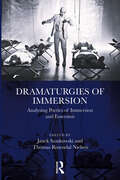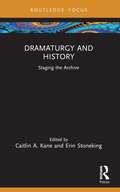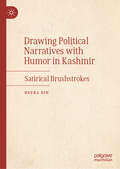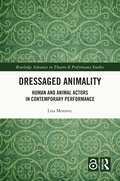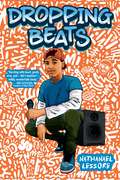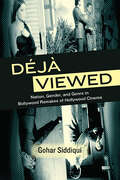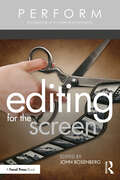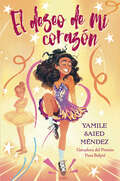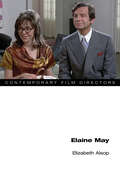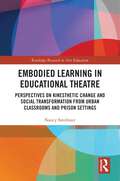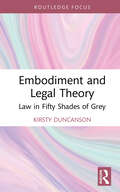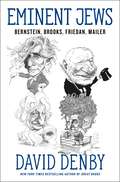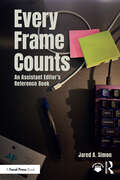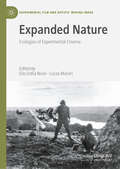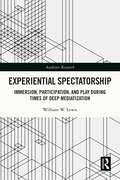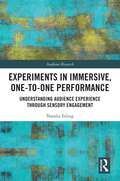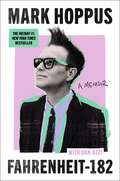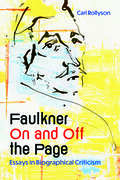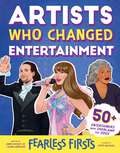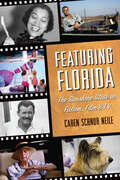- Table View
- List View
Directors Tell the Story: Master the Craft of Television and Film Directing
by Bethany Rooney Mary Lou BelliThe freshest storytelling today is on television, where the multi-episodic format is used for rich character development and innovative story arcs. This exciting new edition of Directors Tell the Story continues to offer rare insight and advice straight from two A-list television directors whose credits include Elsbeth, Tracker, Criminal Minds: Evolution, The Ms. Pat Show, Chicago Med, and many more.Here, in one volume, learn everything you need to know to become an excellent director. Covering everything through prep, shoot, and post, the authors offer practical instruction on how to craft a creative vision, translate a script into a visual story, establish and maintain the look and feel of a television show or film, lead the cast and crew, keep a complex operation running on time and on budget, and effectively oversee editing and postproduction. Directors Tell the Story provides behind-the-scenes access to the secrets of successful directors, as well as exercises that use original scripted material.This newly updated edition features: More roles on set, including on-set writers, producing directors, intimacy coordinators, virtual production supervisors, and virtual production designers New material covering updates to cameras, lighting, and new innovations in sound Updated “Insider Info” sections with advice and tips known only to working professionals Profiles of top film and TV luminaries Additional “How I Got My First Directing Job” stories from a diverse range of directors currently in the trenches Suited to students in both beginning and intermediate level directing and production courses, as well as aspiring professionals, this book provides valuable insight. The work is supported by a fresh instructor and student online resource featuring directing tutorials and video interviews with the authors.
Disney Princess Enchanted Character Guide
by DKMeet all 13 Disney Princess characters in this enchanting, official guide for young fans – now updated with new pages to include Moana and RayaStep into the fairy-tale world of Disney's amazing Princesses! Jump into adventures with Moana, dance with Cinderella at the ball, and join Jasmine on her magic carpet ride as you discover, learn, and marvel at everything you need to know about these beloved characters.Featuring everything you need to know about the enchanting Disney Princesses:Newly updated with everything you need to know about the most recent Disney Princess characters, Moana (Moana) and Raya (Raya and the Last Dragon) Follows the twists and turns of each princess’s story with data files, fun facts, and gorgeous images for all 13 official Disney PrincessesBeautifully printed with gold foil and high-quality paper, this edition is a beautiful gift to treasure for young Disney Princess fansTurn the pages of this enchanting guide to follow the wonderful tales within, freshly updated to include the newest additions to the Disney Princess family. From Tiana and Merida to Belle and Ariel, follow their captivating stories, meet their friends and foes, find out fun facts, and feast your eyes on beautiful pictures from these magical worlds.© 2025 Disney
Disney/Pixar The Art of Elio (Disney/Pixar)
by Pixar Animation StudiosThis stunning book showcases the art, behind-the-scenes details, and making of the Disney and Pixar animated film ElioThe next in the fan-favorite, collectible Disney and Pixar Art of series, The Art of Elio presents the story behind the out-of-this-world film from Pixar Animation Studios. Adventure across the galaxy with alien-obsessed Elio in this essential story of connection, friendship, and searching for your place in the world, or in this case, universe. This book highlights the stunning artwork from the film's creation—including character designs, storyboards, color scripts, and much more—and features exclusive interviews with the creative team along with behind-the-scenes details. This book is the perfect gift for aspiring artists, animators, film buffs, and fans.© 2025 Disney Enterprises, Inc. and Pixar. All rights reserved. EXCLUSIVE LOOK AT ANIMATION FILMMAKING: Fans will want to delve into and explore this Pixar Animation film through production art, stories, and making-of details exclusive to this book.PART OF THE FAN-FAVORITE SERIES: The collectible Art of series is perfect for animation enthusiasts, filmmakers, students, and fans of Disney and Pixar. Add The Art of Elio to the shelf with other bestselling books like The Art of Elemental, The Art of Turning Red, and The Art of Soul.Perfect for:Animators and animation studentsDisney fans of all agesCinephiles and movie buffsPop culture enthusiasts and historiansFamilies that love watching Disney and Pixar films togetherFans of sci-fi books and moviesPeople interested in aliens, extraterrestrials, space, and space travel
Double Crossed: Black Female Intersectionality in Hollywood (Race, Rhetoric, and Media Series)
by Frederick W. Gooding Jr.Despite Hollywood’s recent efforts to appeal to more racially diverse audiences, mainstream movies routinely present a limited view of non-Whites generally, and Black women specifically, in stark contrast to the broadly developed spectrum of White characters. Black women characters are frequently rendered invisible, and even in films featuring their image, Black women characters too often fall prey to historically stereotypical patterns. These consistently marginalized Black female images serve to reflect and reinforce messages of racial imbalance distributed worldwide. In Double Crossed: Black Female Intersectionality in Hollywood, author Frederick W. Gooding Jr. chronicles the Black female experience through the lens of Hollywood. Gooding begins by contextualizing the origins of early Black female imagery on screen, largely restricted to the domestic mammy figure, then traces how these images have shifted over time. Through close readings of such films as Gone with the Wind, Bringing Down the House, The Princess and the Frog, and The Help, as well as case studies looking at Oprah Winfrey and Shonda Rhimes, Gooding considers not only the image the Black woman creates, but also the shadow she casts. This volume demonstrates the historical, economic, and social consequences of Hollywood’s distorted representation of Black women on screen and in real life.
Dramaturgies of Immersion: Analysing Poetics of Immersion and Emersion
by Janek Szatkowski Thomas Rosendal NielsenDramaturgies of Immersion draws on case studies from international productions to conceptualise and analyse the state of contemporary immersive theatre. Immersion appears in different forms, raising the core question: What is at stake in immersive theatre for participants, artists, and society? The answer depends on the underlying values of the different immersive poetics.The book takes a multifaceted approach to immersive theatre and its dramaturgies to explore the forms of emersion rendered possible by immersion in a number of cases from international and Danish performances. The edited collection examines how theatre in the 21st century finds adequate forms that allow it to both entertain and stay socially relevant. The chapters build on each other, developing a specific way of thinking about and analysing dramaturgies in immersive theatre, as well as offering tools for dramaturgical analysis.An insightful exploration of the potentials of immersive theatre, Dramaturgies of Immersion is essential for advanced undergraduate and postgraduate students of dramaturgy and immersive theatre, scholars and researchers in these fields, as well as theatre practitioners.
Dramaturgy and History: Staging the Archive (ISSN)
by Caitlin A. Kane Erin StonekingDramaturgy and History provides a practical account of an aspect of dramaturgical practice that is often taken for granted: dramaturgs’ engagements with history and historiography.Dramaturgs play a vital role in amplifying and activating theatre’s unique potential to contribute to the pressing public discourse around the uses and legacies of history.This collection challenges the notion of history as an unassailable or settled set of facts, offering readers a glimpse into the processes and methods of eighteen dramaturgs working in a variety of settings, including professional theatres, universities, museums, and archives. The dramaturgs featured use history to a variety of ends: they reframe classical texts for contemporary audiences; advocate for the production of lesser-known writers and the expansion of the canon; create new works that bring women’s, LGBTQIA+, and Global Majority histories to life; and establish new and necessary archives by/of/for minoritarian artists. Collectively, they examine and animate some of the most urgent questions, concerns, and challenges that dramaturgs encounter in working with history.An essential resource for teachers and students of dramaturgy, the collection offers a concluding hands-on exercise for each chapter to facilitate the reader’s application of the methods discussed in their own practice.
Drawing Political Narratives with Humor in Kashmir: Satirical Brushstrokes
by Heeba DinThis book explores the remarkable ability of political cartoons in the region to craft and preserve an alternative narrative by employing the potent tool of political humor. Over the centuries, political humor, delivered through satire, caricature, ridicule, or irony, has been a powerful instrument for scrutinizing the establishment and unveiling the shortcomings and absurdities within society. In this book, the author delves into the meaning-generational structures utilized by political cartoons to amplify the underlying political-socio-cultural ideologies. It also investigates the pivotal role of political humor in shaping and defining the discourse in Kashmir. This book sheds light on the enduring impact of satire and caricature as instruments for not only commenting on contemporary issues but also for creating and sustaining a collective memory that reflects the complex sociopolitical dynamics that have characterized Kashmir throughout its history.
Dreaming Down the Track: Awakenings in Aboriginal Cinema
by William LempertWhat can Aboriginal filmmaking reveal about Indigenous presence and futures? The product of years of embedded fieldwork within Indigenous film crews in Northwestern Australia, Dreaming Down the Track delves deeply into Aboriginal cinema as a transformative community process. It follows the social lives of projects throughout their production cycles, from planning and editing to screening, broadcasting, and after-images. Across its narrative sweep, this ethnography engages the film career of Kukatja elder Mark Moora to demonstrate the impact of filmmaking on how Aboriginal futures are collectively imagined and called forth. William Lempert highlights a series of awakenings through which Moora ultimately came to view cinema as a process for catalyzing his family&’s return to their home country of Mangkayi. This biographical media journey paints an intimate portrait of the inspiring possibilities and sobering limitations of Indigenous envisioning within settler states. Lempert traces how Moora&’s life and films convey a multiplicity of Aboriginal experiences across time and space, from colonial contact to contemporary life in communities like Balgo, including the continued governmental attempts to undermine them. Amid ongoing negotiations to establish the first treaties between Indigenous nations and Australian states, Dreaming Down the Track illustrates what is at stake in how Aboriginal–State relations are represented and understood, both within communities and for the broader public. Lempert stays true to Moora&’s insight that film can preserve community stories for generations to come, toward the aim of enacting sovereign futures.
Dressaged Animality: Human and Animal Actors in Contemporary Performance (Routledge Advances in Theatre & Performance Studies)
by Lisa MoravecThe book applies a productive interdisciplinary lens of art history, performance, and animal studies for approaching political economy issues, critiquing anthropomorphic worldviews, and provoking thoughts around animal and human nature that spark impulses for an innovative performance aesthetics and ethics.It combines Marxist analysis with feminist and posthumanist methodology to analyse the relation between ‘societal dressage’ and ‘bodily animality’ that humans and animals share. Within this original theoretical framework, the book develops the concept of ‘dressaged animality’ as a mode of critique to analyse the social and political function of interdisciplinary forms of ‘contemporary performances.’Drawing on archival and primary research, the book theorises and historicises more than 15 performance practices in which animality is allegorically staged through by humans danced, real, or filmically mediated animals. It focuses on Rose English’s pioneering approach to performance-making as well as on overlooked performances by other renown and largely unknown American (Mike Kelley/Kate Foley, Robert Morris, Bruce Nauman, Yvonne Rainer, Diana Thater), British (Mark Wallinger, Rose English), and European artists (Tamara Grcic, Judith Hopf, Joseph Beuys, Bartabas) from the late 1960s until the late 2010s. While various types of artistic practice are framed as forms of critique (for example, protest art, interventionist strategies, institutional critique), the book maps an original performance theory in art which shows that contemporary artistic performances can also take up a critique of societal dressage.This study will be of great interest to students and scholars in art history, theatre, dance and performance studies, and ecology, as well as to artists and curators working with performance.
Dropping Beats
by Nathanael Lessore"Funny, bursting with heart, goofy, wise, and did I mention– wildly wonderfully funny." —Jon Scieszka, First National Ambassador of Young People's Literature and Founder of Guys ReadA hilarious and heartfelt young YA comedy about the misadventures of an aspiring young rapper as he navigates school, family, and friendship. Thirteen-year-old Growls (aka Shaun) is an aspiring (awful) rapper who hopes to enter this year&’s Raptology competition with his best friend, Shanks (aka Zachariah). After all, what better way to land his crush (Tanisha) and get the respect he finally deserves than winning the contest and going viral? But when a livestream practice goes epically wrong, the two friends do go viral– and not in the way they&’d hoped. Now the laughingstock of the school, Growls is sure he&’ll never have another chance to date Tanisha. Even worse, Shanks has gone MIA, leaving him terribly alone. But when Growls meets the new girl on the block (Siobhan), things don&’t seem so terrible after all. And with some patience, a little luck, and a whole lot of practice, he just might win the Raptology competition and be a hero to both Siobhan and Shanks. Either way, he&’s ready for this. He&’s steady for this. It&’s comeback season and they call him comeback king for a reason.
Déjà Viewed: Nation, Gender, and Genre in Bollywood Remakes of Hollywood Cinema (SUNY series, Horizons of Cinema)
by Gohar SiddiquiSituates the remake as one of the primary responses to Bollywood's globalization and corporatization.Focused on post-1990 Bollywood remakes of Hollywood films, Déjà Viewed tells a larger story of the rapidly changing Indian film industry in the wake of globalization and corporatization. It situates the remake as a gendered response to these changes, drawing on approaches from film theory, gender studies, and cultural studies. The book looks at films from a variety of genres and modes, including the Bollywood family film, romantic comedy, noir, and melodrama, and each film's close analysis is accompanied by attention to concerns related to remake theory, such as homage, anxiety of influence, defamiliarization, and pastiche. Seeking to historicize how gender and genres become translated and transformed in the Bollywood remake, the book contributes to transnational understandings of gender and genre as media texts move across various borders—geographic, cinematic, economic, and aesthetic.
Editing for the Screen (ISSN)
by John RosenbergCombining essays and interviews with editors from film and television, this collection explores the business side of film editing. Over 30 industry professionals dispel myths about the industry and provide practical advice on the business of film and TV editing.John Rosenberg has brought together contributions from Dody Dorn (Momento), Scott Conrad (Rocky), Kevin Tent (The Holdovers), Bruce Green (Cool Runnings), Nancy Forner (Buffy the Vampire Slayer), and Yu Jung Hou (American Born Chinese), among others, to provide diverse perspectives on editing a variety of formats from feature films to sitcoms, working with other departments, and breaking into the field as an assistant editor. Building on the craft of editing and looking at how aspiring editors can apply this to the industry, readers are taken through the process from getting started in the industry, to progressing through your career and getting ahead as an editor. Readers will also learn about entrepreneurial expectations in relation to marketing, strategies for contending with the emotional highs and lows of editing, and money management whilst pursuing a career in editing for film and television.Written for undergraduates and graduates studying film and TV editing, as well as aspiring editors, this book provides readers with a wealth of first-hand information that will help them create their own opportunities and pursue a career in film and television.
El deseo de mi corazón: (The Reel Wish)
by Yamile Saied MéndezCuando un ataque de panico impide que Florencia actúe como Clara en El Cascanueces y su mejor amiga actúa como Clara en lugar de ella, un nuevo estilo de baile la ayuda a enfrentar su ansiedad y una amistad problemática. After a panic attack prevents Florencia from performing as Clara in The Nutcracker and her best friends takes the lead, a new dance style helps her face her anxiety as well as a troubled friendship.El ballet lo es todo para Florencia del Lago. Después de años de arduo trabajo, es seleccionada como Clara en la producción invernal de El Cascanueces. No sólo es la bailarina más joven en recibir tal honor sino también la primera latina. Está en camino de ser contratada por las mejores compañías de ballet. Desafortunadamente, la noche del estreno, sufre un ataque de pánico-- en el escenario, delante de todos. Y luego Selena, su mejor amiga, la reemplaza como Clara. Así, se desmorona su mundo entero-- el estudio de ballet la expulsa, y su mejor amiga se vuelve contra ella, atormentándola en las redes sociales y en la vida real. Pero a pesar de que algo que ella amaba llegó a su fin, la terapia y el apoyo familiar la ayudan a abrirse a nuevas experiencias. Forma una amistad con dos chicos de la escuela a los que nunca les había prestado atención, e incluso se encuentra con una escuela de danza irlandesa y decide intentar aprender esta nueva forma de arte. ¿Podrá una nueva pasión por la danza irlandesa ayudarla a encontrar la alegría de bailar en el escenario que perdió aquella noche de invierno? Ballet is Florencia del Lago's entire world. After years of hard work, she is chosen as Clara in the winter production of The Nutcracker. Not only is she the youngest dancer to receive such an honor but also the first Latina. She's on track to be recruited by the best ballet companies. Unfortunately, she suffers a panic attack on opening night--on stage, in front of everyone. And then Selena, Florencia's best friend, steps right into the role to replace her. Just like that, Florencia's whole world falls apart--the ballet studio expels her, and her best friend turns on her, tormenting her on social media and in real life. But even though the one thing she was driven toward has come to an end, therapy and family support help Florencia open up to new experiences. She notices people at school she's never paid attention to before, and she even stumbles upon an Irish dance school and decides to give it a try. Can a new passion for Irish dance help Florencia find the joy of performing on the stage that she lost that fateful winter night?
Elaine May (Contemporary Film Directors)
by Elizabeth AlsopA master of subverting tropes with surgical precision, Elaine May forged a career in 1970s Hollywood with films like The Heartbreak Kid and Mikey and Nicky. Elizabeth Alsop explores the director’s non-conformist and uncompromising vision while looking at May’s films against trends in classic and post-classical Hollywood. Shaped by her background and success in the theater, May brought the biting humor of her improv comedy to her filmmaking. But unfriendly media and a system hostile to both her methods and sensibility consigned her to “director’s jail” after the failure of Ishtar. As Alsop moves through the filmmaker’s four movies, she tracks May’s inventive treatment of favorite themes like hapless male characters and the inanities of American culture. She also considers May’s work in relation to her multifaceted career as a writer and performer. A compelling reconsideration of an iconoclast and original, Elaine May reveals how a surprisingly radical auteur created her trademark cinema of discomfort.
Embodied Learning in Educational Theatre: Perspectives on Kinesthetic Change and Social Transformation from Urban Classrooms and Prison Settings (Routledge Research in Arts Education)
by Nancy SmithnerThis book explores embodied teaching practices through applied and physical theatre, drawing extensively on the author’s rich experience teaching in diverse urban environments, including schools, colleges and prison settings.It presents a groundbreaking conceptualization of embodied practice aimed at fostering personal and social growth through educational theatre. Each chapter delves into theories of social transformation, supported by qualitative data from student reflections, to provide both theoretical and practical insights. These insights illustrate how physicalized pedagogy can be effectively used to engage students with socially transformative ideas and identities. It also emphasizes the significant role of the facilitator in this process, highlighting how they can create an environment that fosters ethical and multicultural awareness in both formal educational settings, such as classrooms, and informal settings, like community workshops. By promoting an ethos of inclusivity and ethical consideration, it argues that facilitators can help students navigate and engage with complex social issues through the medium of theatre.An accessible and compelling text, it aims to inspire educators to adopt innovative methods that promote deeper engagement and understanding among students.
Embodiment and Legal Theory: Law in Fifty Shades of Grey
by Kirsty DuncansonThis book addresses the importance of the body in legal theory, through an analysis of the film Fifty Shades of Grey.As physical beings, we experience law in sensations of outrage when it is applied unethically, righteousness when it finds justice, and joy when it establishes partnerships in marriage. Our bodies feel and know law. In Embodiment and Legal Theory, it is argued that our bodies also theorise law. It is proposed that our bodies are involved in comprehending, negotiating, and reimagining the legal concepts that shape our lives. As a medium designed to engage us by stimulating our bodily reactions of tears, laughter, shock, and titillation, cinema provides an ideal site for exploring how bodies participate in legal arguments and the construction of legal meaning. For this reason, through a deep analysis of the film Fifty Shades of Grey (2015), this book presents a theory of embodied jurisprudence.At the intersection of legal theory and film studies, this book will appeal to students and scholars in both these areas, as well as in criminology and cultural studies.
Eminent Jews: Bernstein, Brooks, Friedan, Mailer
by David DenbyLeonard Bernstein, Mel Brooks, Betty Friedan, and Norman Mailer. Brilliant, brash, yet soulful, they were 100 percent Jewish and 100 percent American. They upended the restrained culture of their forebears and changed American life.They worked in different fields, and, apart from clinking glasses at parties now and then, they hardly knew one another. But they shared a historical moment and a common temperament. For all four, their Jewish heritage was electrified by American liberty. The results were explosive.As prosperity for Jews increased and anti-Semitism began to fade after World War II, these four creative giants stormed through the latter half of the twentieth century, altering the way people around the world listened to music, defined what was vulgar, comprehended the relations of men and women, and understood the American soul. They were not saints; they were turbulent and self-dissatisfied intellectuals who fearlessly wielded their own newly won freedom to charge up American culture.Celebratory yet candid, at times fiercely critical, David Denby presents these four figures as egotistical and generous—larger-than-life, all of them, yet vulnerable, even heartbreaking, in their ambition, ferocity, and pride.
Every Frame Counts: An Assistant Editor’s Reference Book
by Jared SimonThis book, written by an industry expert, covers the duties of an assistant editor over the course of an entire feature film.Throughout the book, the author provides key insights and advice from years of experience, which will help assistant editors hit the ground running, keep up the pace, and continue thinking critically and creatively. The easy-to-navigate structure loosely follows that of the typical job by identifying and outlining four key phases: Dailies, Director’s Cut, Screenings, and Finishing. Discussed therein are also passages that outline pre-production, the first day on the job, temp sound and VFX work, and turnovers as well as wrap and archiving.Special features include detailed screenshots, advanced tips for interacting with Avid Media Composer (the industry standard for Non-Linear Digital Editing), editorial-specific use cases for automation using FileMaker Pro, and best practices regarding every aspect of the job.This book is an intermediate resource for prospective and current assistant editors in the modern film and television editorial department.
Expanded Nature: Écologies du cinéma expérimental (Experimental Film and Artists’ Moving Image)
by Elio Della Noce Lucas MurariThis book explores the emergence of ecological consciousness in the work of contemporary experimental filmmakers. If it can be said that experimental filmmakers are "expanding" the artistic field through an exploration of the potencies, modes of dissemination and performance of the moving image, in the Anthropocene these practices strive for another kind of expansion: to expand our experience of nature. Appending flowers to the film strip or burying it in the ground, inventing observational devices, allowing the camera to be affected by natural forces, engaging one's own filming body in a symbiotic relationship with the environment, reconstituting ecosystems at the moment of projection: the ecologies of experimental cinema presented in this book constitute forms of practice and engagement that awaken a heightened sensibility towards the living world through cooperative links, casting other beings as subjects and agents of filmic processes, and, finally, reshaping the economy of filmmaking. Thus, ecologies of perception, medium, production, and multinaturalism are deployed, contributing to the restoration of our sensory bond with the natural world. Several chapters were translated with the help of artificial intelligence. In each case, the text has subsequently been revised further by the author as well as the translator Charlie Hewison and a professional copy editor.
Experiential Spectatorship: Immersion, Participation, and Play During Times of Deep Mediatization (Audience Research)
by William W. LewisExperiential Spectatorship offers a lens for analyzing audience experience with(in) a variety of contemporary media. Using a broad-based perspective, this media includes participatory theatre, video games, digital simulations, social media platforms, alternate reality games, choose your own adventure narratives, interactive television, and a variety of other experiential performance events. Through a taxonomy that includes Immersion, Participation, Game Play, and Role Play the book guides the reader to understand the ways mediatization and technics brought about by digital technologies are changing the capacities and expectations of contemporary audiences. In their daily interactions and relations with their technologies, they become mediatized spectators. By reading these technologies' impacts on individual subjectivity prior to acts of spectatorship, one gains the tools to best describe how the spectator creates forms of relational exchange with their experential media.This book prepares the reader to think in a digital manner so they can best recognize how performance and spectatorship in the twenty-first century are evolving to meet the needs of future waves of spectators brought up in a postdigital world.
Experiments in Immersive, One-to-One Performance: Understanding Audience Experience through Sensory Engagement (Audience Research)
by Natalia EslingThis book investigates audience experience through the lens of sensory engagement in immersive, one-to-one performance. It presents a distinct, practice-based research (PBR) framework – a performance research ‘laboratory’ – designed to evaluate the effects on diverse audience experiences of two ‘sense-specific manipulations’: eye masks and touch. Through a qualitative analysis of responses from seventy-four individual audience participants, this book offers insight into how these popular ‘immersing’ strategies might be experienced. What do these strategies achieve? How do audience participants make sense of them? Do audience responses align with artistic intentions? And how does the PBR framework designed to address these questions influence the outcomes? Through an analysis of three sets of one-to-one performance experiments generating comparative data about the experience of sense-specific manipulation, this book proposes the utility of merging methodologies in artistic research with empirical audience research in theatre and performance studies. This study offers a new perspective on the value of sensory-focused, immersive, one-to-one experience as a means of resensitizing audience participants through performance.
Fahrenheit-182: A Memoir
by Dan Ozzi Mark Hoppus***The Instant #1 New York Times Bestseller!***A smart, funny, and refreshing memoir from Mark Hoppus, the vocalist, bassist, and founding member of pop-punk band blink-182.This is the story of an angst-filled kid from the desert, navigating the chaos of his parents' bitter divorce and searching for his place in the world. Each move across the country was a chance to reinvent himself, switching identities from dork to goth to skate punk, and eventually meeting his best friend who just so happens to be his musical soulmate. With sharp humor and raw honesty, Fahrenheit-182 takes readers through Mark's formative years as a latchkey kid in the 1980s, hooked on punk rock, skateboards, and MTV. Along the way, Mark reflects on his lifelong battle with anxiety, his celebrated career with blink-182, and his public fight with cancer, in a voice that’s both relatable and unmistakably his own.Threaded with sharp humor and heartfelt grit, Fahrenheit-182 is more than just a memoir for blink-182 fans. It’s a funny, smart, and deeply human story for anyone who’s struggled, reinvented themselves, wanted to quit but kept going.
Faulkner On and Off the Page: Essays in Biographical Criticism
by Carl RollysonThough numerous biographies have been published on William Faulkner, readers are often presented conflicting interpretations of his life and work. Faulkner’s view of himself and his own family was mercurial, and it is widely acknowledged that Faulkner was an unreliable narrator of his own life. As a result, biographies of Faulkner echo and complicate the multitude of ways he portrayed himself, accepting that truth—if it exists—is subjective. Like his work, Faulkner’s own life, then, is not only open to different readings but welcomes them within the landscape of his oeuvre.Faulkner On and Off the Page acknowledges the challenges of “factifying” a life into a textual narrative, while also emphasizing the potential for biography to establish a throughline that traces how literature emerges from life and, in turn, shapes the life narrative Faulkner constructed for himself. Unburdened by the sanctity of the written word, Faulkner embraced mutability and perpetual evolution. This process of reinvention also manifests within the pages of Faulkner's biographies, as each biographer brings a unique context and perspective shaped by generations of Faulkner scholars.Rather than thinking of Faulkner as exclusively the great high modernist who strayed to Hollywood when he needed the money and stayed home when he didn’t, this book portrays an unsettled writer incessantly on the move incorporating what only looked like alien elements into his work, while maintaining a public persona that disparaged anything that did not fit the narrative of the novelist he created in interviews, essays, and speeches. This book attempts to carry on the work of finding the man on the page even as he is shaping a life off of it.
Fearless Firsts: Artists Who Changed Entertainment (Fearless Firsts)
by Ellen Labrecque James Buckley Jr.Celebrate 50+ artists who broke barriers, took risks, and changed the world of entertainment forever!While these creatives came from different backgrounds and overcame unique struggles, they had one thing in common: they would not take "You can't" for an answer. With a don't-give-up attitude, these fearless firsts fought for what they believed in and created a better artistic world.In this book, you'll read about very famous entertainers, like Taylor Swift and Oprah Winfrey. You'll also discover the first Asian American comic book writer and the first runway model in a wheelchair. You'll meet the world's first modern graffiti artist, the first Black man to host a TV series, and the first Indigenous American Oscar winner. Beyond individuals, you'll learn about important groups, like the East West Players and the Hamilton cast. By the time you're done reading, whether you see yourself as an artist or not, you'll be inspired to stay optimistic, fight against injustice, and be fearless in whatever you set your mind to!
Featuring Florida: The Sunshine State in Fiction, Film & TV
by Dr Caren S. NeileAuthor Caren Schnur Neile offers a whole new way to explore Florida. Dexter, Key Largo, The Yearling—all famous works of popular culture created by masters in their fields. What’s more, all three take place in Florida. This plunge into Florida-based TV, movies and fiction from the nineteenth century to the present both entertains and educates about the Sunshine State and the stories themselves. Did you know who producers originally wanted to star in Bad Boys or which product saw skyrocketing sales thanks to Miami Vice? Florida enthusiasts will also find a good, long list of enticing shows and books to enjoy, from old favorites like Their Eyes Were Watching God, Scarface and The Golden Girls to newer masterpieces like The Florida Project and Moonlight.
